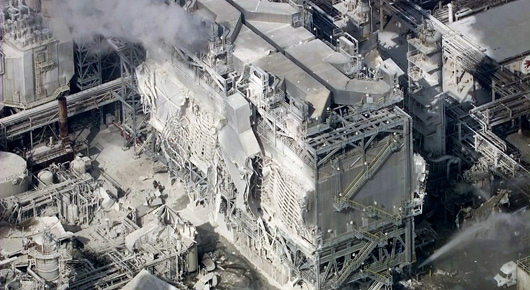
PITTSBURGH (PAI) – The Steelworkers and the California Occupational Safety and Health Administration (CalOSHA) have opened talks with ExxonMobil about how to solve rampant safety problems in the oil firm’s Torrance, Calif., refinery after a federal investigative agency revealed last year’s explosion there was a near-miss of a disaster.
“Things are going fine” in the talks with ExxonMobil about how to solve the problems, “but it’s a slow process,” says Kim Nibarger, the Steelworkers vice president who now heads its oil, chemical and atomic workers sector. Nibarger was formerly USW’s top overall safety and health official.
But in an indication ExxonMobil still is recalcitrant, the company “didn’t share that same vision” by the feds of the near-miss, “which is quite disappointing,” Nibarger adds.
On Jan. 13, the U.S. Chemical Safety Board unveiled its findings about the Feb. 18, 2015 accident at Torrance, which injured two workers. The Steelworkers represent the Torrance refinery workers, as well as two-thirds of all U.S. refinery workers.
But this Torrance accident could have been a lot worse, CSB Chair Vanessa Allen Sutherland reported.
The refinery’s electrostatic precipitator (ESP) which helps control air pollution, exploded after hydrocarbons (gases) built up in it over six days, CSB found. The “blast dispersed large quantities of catalyst dust up to a mile away” from the refinery, CSB added.
The blast also hurled large ESP pieces elsewhere around the refinery. One narrowly missed its alkylation unit, including a tank with thousands of pounds of modified hydrofluoric acid (HF). “Had the debris struck the tank, a rupture could have been possible, resulting in a potentially catastrophic release of extremely toxic modified HF into the neighboring community,” the board reported.
“Hydrofluoric acid can pose a severe hazard to the population and environment if a release occurs,” Sutherland explained. CSB noted 333,000 people live within a 3-mile radius of the refinery. That area also contains 71 schools and eight hospitals.
“After HF acid vaporizes it condenses into small droplets that form a dense low-lying cloud that will travel along the ground for several miles and can cause severe damage to the respiratory system, skin, and bones of those who are exposed, potentially resulting in death,” CSB said.
It’s that hydrofluoric acid threat that concerned CSB and concerns Nibarger, too, he said in a telephone interview with Press Associates Union News Service.
“The issue in our settlement discussions” with the state agency and ExxonMobil “has been company reluctance to give out information about the HF alkylation unit,” he said.
“It’s something you’d want to look at, wouldn’t you think?” he asked.
The Torrance blast occurred last year just as the oil industry forced the Steelworkers to strike nationwide over safety issues. The refiners had refused to address the problem, even though federal Occupational Safety and Health Administration records and information from other sources showed the industry averaged one refinery accident a week for the prior five years, and some of them fatal.
Publicity surrounding the strike, and the reasons why, forced the oil firms to settle with USW and to promise to address two of the key safety issues it raised: Fatigued workers and adequate safety staffing. They also agreed to more USW monitoring of refinery conditions.
But ExxonMobil is still having trouble responding to CSB’s call for top-to-bottom “process safety management” inspections of refineries by the federal and California OSHA’s, CSB Chair Sutherland said. CSB’s chief investigator, Mark Wingard, said the firm had “multiple process safety management deficiencies” at the Torrance plant.
CSB found similar problems, and lack of company oversight, after a notorious August 2012 Chevron refinery blast in nearby Richmond, Calif. That explosion and fire injured 19 workers and sent 15,000 people to hospitals for examination.
Nibarger said some of the nation’s oil companies, the so-called “Seven Sisters,” are responding to key issues the union emphasized in its contract talks. “But others have balked, or sent us information on an aggregate level, and not on a unit (refinery by refinery) level,” he added. Some sent USW “a jumble of charts and graphs” on safety.
But with ExxonMobil and CalOSHA in the Torrance refinery talks, “I’m hopeful we can do something,” Nibarger says. “It’s to everybody’s benefit to have adequate, well-rested, well-trained staff” of refinery workers “in place” to stop accidents before they start.
Photo: Torrance refinery explosion. | Nick Ut/AP








